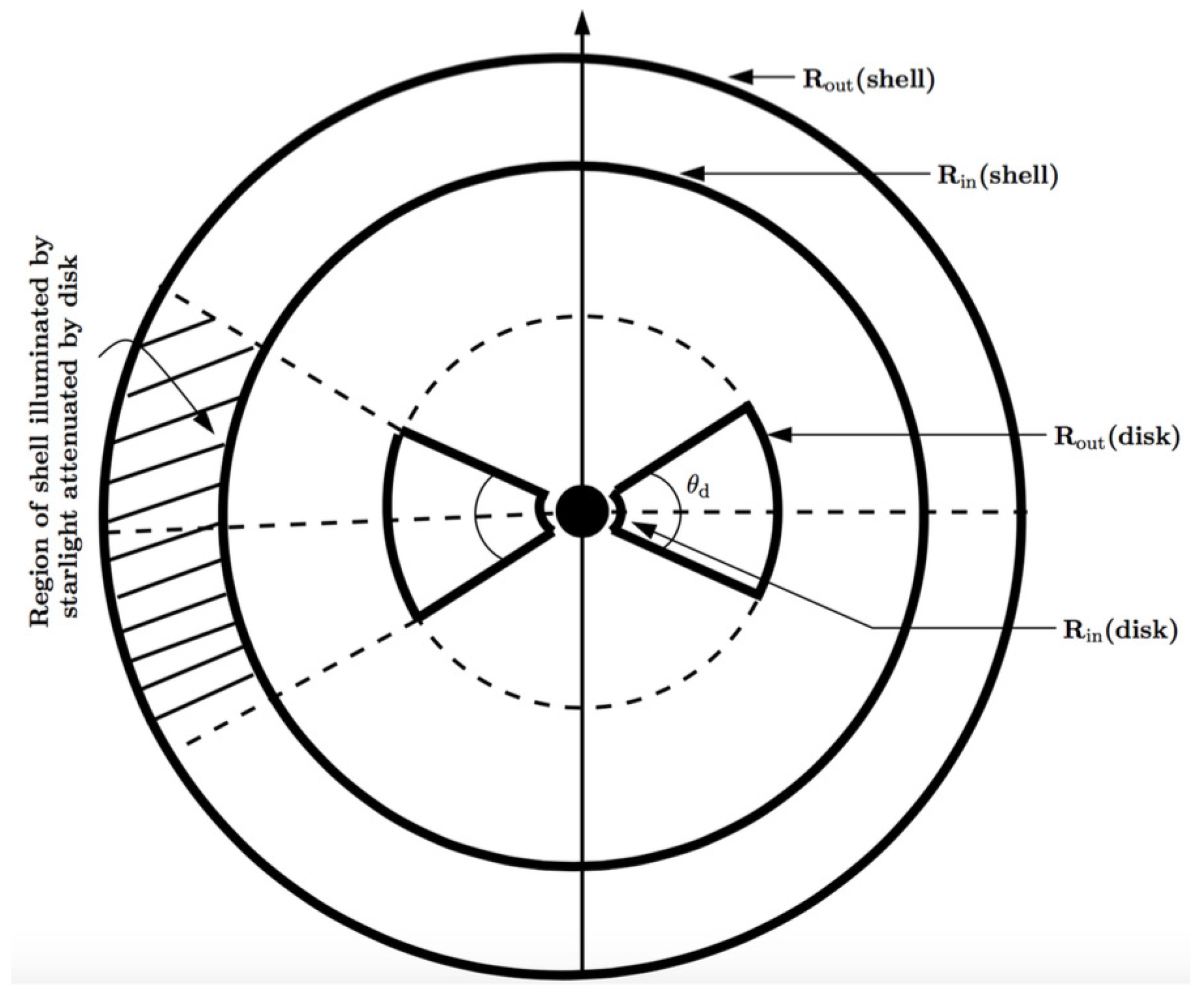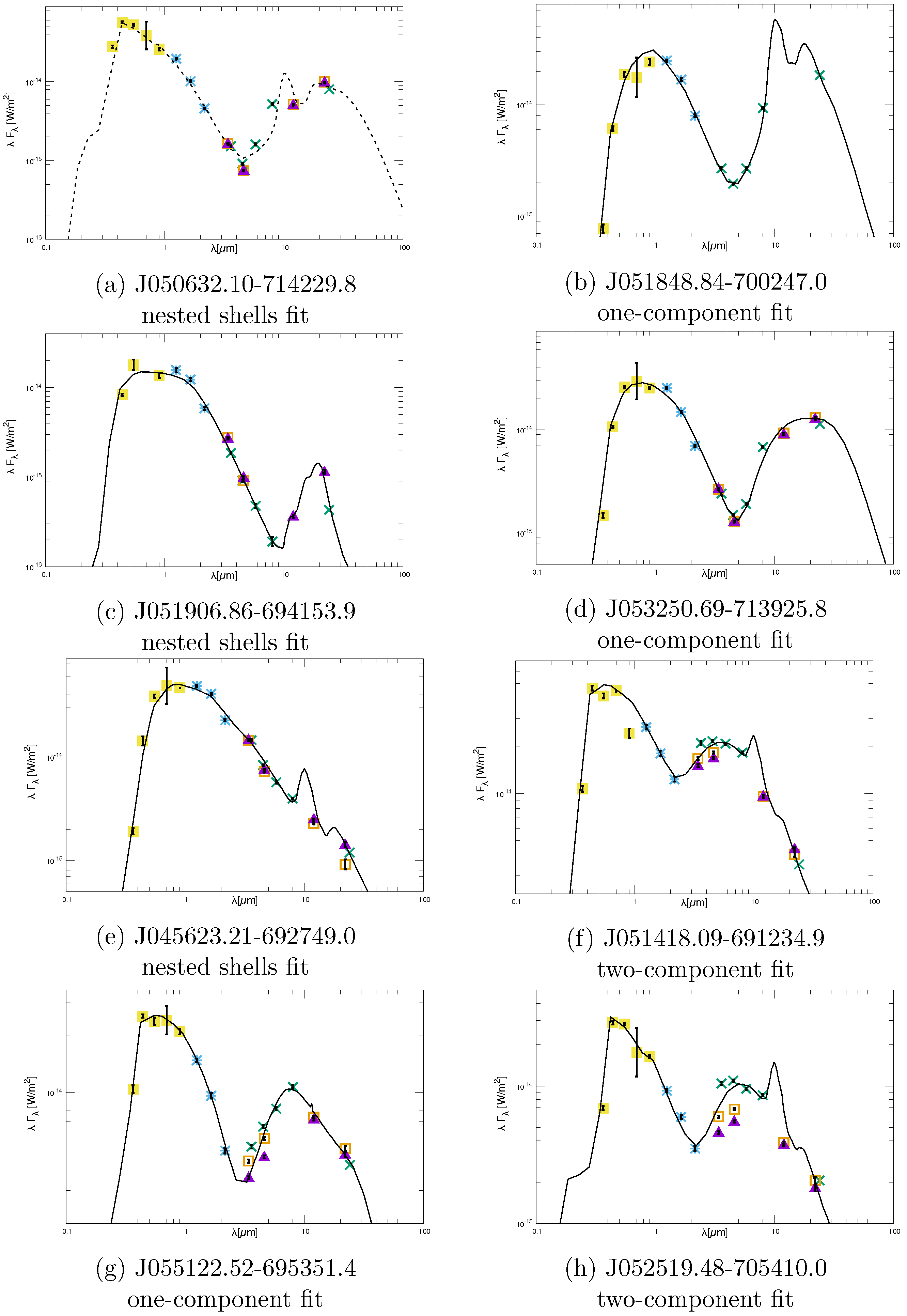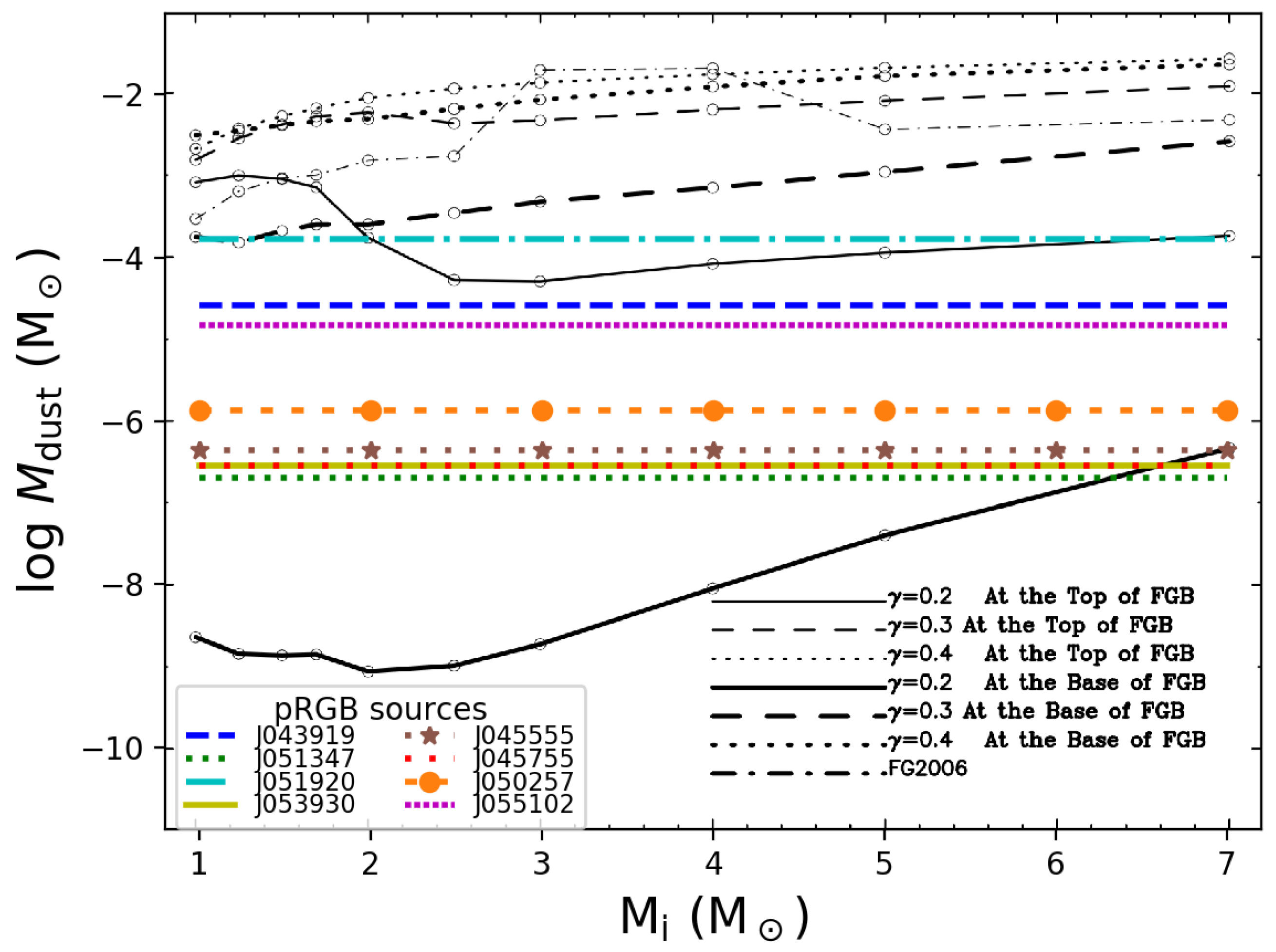A Study of the Dusty Disks and Shells around Post-RGB Stars in the LMC
Abstract
1. Introduction
2. Sample Selection
3. Modeling the Circumstellar Dust
4. Derived Parameters
5. Results
- We found that the published classification of these objects as ”shell” or ”disk” sources was not robust. While shells were present in all sources, our modeling showed that, additionally, the presence of a disk was (a) required in some ”shell” sources (the post-RGB sources: J043919.30-685733.4 and J051920.18-722522.1) and (b) not required in some ”disk” sources (the post-AGB sources: J045623.21-692749.0 and J055122.52-695351.4).
- With the exception of the post-RGB source, J045555.15-712112.3, the disk fractions in the post-RGBs were surprisingly large (typically 0.3–0.4), implying disks with large opening angles (∼) and hence were geometrically thick structures. The large opening angles appeared to be roughly consistent with the gas density of the ejected envelope as seen in numerical simulations of CEE, relatively soon after CEE occurred (e.g., see Figure 1 of García-Segura et al. [36]).
- We derived the total dust mass in the disks and shells and set rough constraints on the dust grain composition and sizes. The shells are significantly more massive than the disks. The dust mass in the disks of post-RGB (post-AGB) sources lies in the range of M ( M) and in the shells from M ( M).
- We found evidence that, for some post-RGB sources, the ejected matter may be carbon-rich, even though it is expected to be oxygen-rich. For the post-RGB star, J055102.44-685639.1, our modeling revealed that the disk is optically thick ( = 1.0) and amC-Hn grains provided a reasonable fit to the SED in the near and mid-infrared. The cool outer shell has a combination of warm silicates and silicon carbide. While amorphous carbon has been observed in the dusty disk around C-rich post-AGB stars (e.g., HR4049, Acke et al. [37], we do not expect to see it in the circumstellar environment of a post-RGB star because such dust is believed to form when the C/O ratio is >1 in the star’s atmosphere, following formation of C via 3- nucleosynthesis and (the third) dredge-up—events that occur at the centers of AGB stars. The carbon-rich circumstellar chemistry may be explained if the post-RGB star is a CH giant in a binary system that formed when the post-RGB progenitor accreted carbon-rich matter from a more massive AGB companion (now a WD) before undergoing CE ejection.
- We found systematic discrepancies between the model and observed SEDs in the 5.8–8 m region for some of our sources—J043919.30-685733.4, J045555.15-712112, J045755.05-681649.2, J050257.89-665306.3 and J050632.10-714229.8. These discrepancies may be explained by the presence of PAHs in the dust disks/shells of our sources, e.g., PAH molecules have been found in the circumstellar environment of the oxygen-rich red giant, HD233517 (Jura et al. [38]). The presence of PAHs provides independent support for the hypothesis of binary interaction leading to the formation of post-RGB objects.
- The amorphous silicate emission features at 10 m and 18 m are visible in the model spectra of several of our objects.
- Comparison of our model results with predictions of dust mass in the circumstellar ejecta of binary systems wherein the primary is a red giant suggests that CE ejection occurred near or at the tip of the RGB.
6. Discussion
Author Contributions
Funding
Data Availability Statement
Acknowledgments
Conflicts of Interest
References
- Bujarrabal, V.; Alcolea, J.; Sahai, R.; Zamorano, J.; Zijlstra, A.A. The shock structure in the protoplanetary nebula M1–92: Imaging of atomic and H_2 line emission. Astron. Astrophys. 1998, 331, 361–371. [Google Scholar]
- García-Lario, P.; Riera, A.; Manchado, A. Optical and Infrared Observations of the Bipolar Proto-Planetary Nebula Henize 401. Astrophys. J. 1999, 526, 854–861. [Google Scholar] [CrossRef]
- Hrivnak, B.J.; Smith, N.; Su, K.Y.L.; Sahai, R. A Study of H2 Emission in Three Bipolar Proto-Planetary Nebulae: IRAS 16594-4656, Hen 3-401, and Rob 22. Astrophys. J. 2008, 688, 327–343. [Google Scholar] [CrossRef]
- Kwok, S.; Su, K.Y.L.; Hrivnak, B.J. Hubble Space Telescope V-Band Imaging of the Bipolar Proto-Planetary Nebula IRAS 17150-3224. Astrophys. J. 1998, 501, L117–L121. [Google Scholar] [CrossRef]
- Kwok, S.; Hrivnak, B.J.; Su, K.Y.L. Discovery of a Disk-collimated Bipolar Outflow in the Proto-Planetary Nebula IRAS 17106-3046. Astrophys. J. 2000, 544, L149–L152. [Google Scholar] [CrossRef]
- Sahai, R.; Trauger, J.T.; Watson, A.M.; Stapelfeldt, K.R.; Hester, J.J.; Burrows, C.J.; Ballister, G.E.; Clarke, J.T.; Crisp, D.; Evans, R.W.; et al. Imaging of the EGG Nebula (CRL 2688) with WFPC2/HST: A History of AGB/Post–AGB Giant Branch Mass Loss. Astrophys. J. 1998, 493, 301–311. [Google Scholar] [CrossRef]
- Sahai, R.; Trauger, J.T. Multipolar Bubbles and Jets in Low-Excitation Planetary Nebulae: Toward a New Understanding of the Formation and Shaping of Planetary Nebulae. Astron. J. 1998, 116, 1357–1366. [Google Scholar] [CrossRef]
- Sahai, R.; Morris, M.R.; Villar, G.G. Young Planetary Nebulae: Hubble Space Telescope Imaging and a New Morphological Classification System. Astron. J. 2011, 141, 134–164. [Google Scholar] [CrossRef]
- Phillips, J.P.; Ramos-Larios, G. Spitzer mid-infrared observations of seven bipolar planetary nebulae. Mon. Not R. Astron. Soc. 2010, 405, 2179–2205. [Google Scholar] [CrossRef]
- Wegner, G.; Glass, I.S. A new bipolar nebula in Centaurus. Mon. Not. R. Astron. Soc. 1979, 188, 327–330. [Google Scholar] [CrossRef][Green Version]
- Sahai, R.; Nyman, L.-A. The Boomerang Nebula: The Coldest Region of the Universe? Astrophys. J. 1997, 487, L155–L159. [Google Scholar] [CrossRef]
- Sahai, R.; Vlemmings, W.H.T.; Nyman, L.A. The Coldest Place in the Universe: Probing the Ultra-cold Outflow and Dusty Disk in the Boomerang Nebula. Astrophys. J. 2017, 841, 110–125. [Google Scholar] [CrossRef]
- Kamath, D.; Wood, P.R.; Van Winckel, H. Optically visible post-AGB/RGB stars and young stellar objects in the Small Magellanic Cloud: Candidate selection, spectral energy distributions and spectroscopic examination. Mon. Not. R. Astron. Soc. 2014, 439, 2211–2270. [Google Scholar] [CrossRef]
- Kamath, D.; Wood, P.R.; Van Winckel, H. Optically visible post-AGB stars, post-RGB stars and young stellar objects in the Large Magellanic Cloud. Mon. Not. R. Astron. Soc. 2015, 454, 1468–1502. [Google Scholar] [CrossRef]
- Kamath, D.; Wood, P.R.; Van Winckel, H.; Nie, J.D. A newly discovered stellar type: Dusty post-red giant branch stars in the Magellanic Clouds. Astron. Astrophys. 2016, 586, L5–L9. [Google Scholar] [CrossRef]
- Keller, S.C.; Wood, P.R. Bump Cepheids in the Magellanic Clouds: Metallicities, the Distances to the LMC and SMC, and the Pulsation-Evolution Mass Discrepancy. Astrophys. J. 2006, 642, 834–841. [Google Scholar] [CrossRef]
- Van Aarle, E.; Van Winckel, H.; Lloyd Evans, T.; Ueta, T.; Wood, P.R.; Ginsburg, A.G. The optically bright post-AGB population of the LMC. Astron. Astrophys. 2011, 530, 90–134. [Google Scholar] [CrossRef]
- Gordon, K.D.; Clayton, G.C.; Misselt, K.A.; Landolt, A.U.; Wolff, M.J. A quantitative comparison of the Small Magellanic Cloud, Large Magellanic Cloud, and Milky Way ultraviolet to near-Infrared extinction curves. Astrophys. J. 2003, 594, 279–293. [Google Scholar] [CrossRef]
- Gao, J.; Jiang, B.W.; Li, A.; Xue, M.Y. The mid-infrared extinction law in the Large Magellanic Cloud. Astrophys. J. 2013, 776, 7–19. [Google Scholar] [CrossRef]
- Ivezić, Z.; Nenkova, M.; Heymann, F.; Elitzur, M. User Manual for DUSTY (V4). 2012. Available online: https://github.com/ivezic/dusty (accessed on 31 January 2022).
- Ossenkopf, V.; Henning, T.; Mathis, J. Constraints on cosmic silicates. Astron. Astrophys. 1992, 261, 567–578. [Google Scholar]
- Draine, B.T.; Lee, H.M. Optical properties of interstellar graphite and silicate grains. Astrophys. J. 1984, 285, 89–98. [Google Scholar] [CrossRef]
- Hanner, M.S. Infrared Observations of Comets Halley and Wilson and Properties of the Grains. NASA Conf. Pub. 1988, 3004, 22. [Google Scholar]
- Pégourié, B. Optical properties of alpha silicon carbide. Astron. Astrophys. 1988, 194, 335–339. [Google Scholar]
- Mathis, J.S.; Rumpl, W.; Nordsieck, K.H. The size distribution of interstellar grains. Astrophys. J. 1977, 217, 425–433. [Google Scholar] [CrossRef]
- Sahai, R.; Zijlstra, A.; Sánchez Contreras, C.; Morris, M. An Icy, Bipolar Proto-Planetary Nebula with Knotty Jets: IRAS 22036+5306. Astrophys. J. 2003, 586, L81–L85. [Google Scholar] [CrossRef][Green Version]
- Sahai, R.; Young, K.; Patel, N.A.; Sánchez Contreras, C.; Morris, M. A massive bipolar outflow and a dusty torus with large grains in the preplanetary nebula IRAS 22036+5306. Astrophys. J. 2006, 653, 1241–1252. [Google Scholar] [CrossRef][Green Version]
- Sarkar, G.; Sahai, R. The Dust Envelope of the Preplanetary Nebula IRAS 19475+3119. Astrophys. J. 2006, 644, 1171–1182. [Google Scholar] [CrossRef][Green Version]
- Van Loon, J.T.; Groenewegen, M.A.T.; de Koter, A.; Trams, N.R.; Waters, L.B.F.M.; Zijlstra, A.A.; Loup, C. Mass-loss rates and luminosity functions of dust-enshrouded AGB stars and red supergiants in the LMC. Astron. Astrophys. 1999, 351, 559–572. [Google Scholar]
- Nanni, A.; Groenewegen, M.A.T.; Aringer, B.; Rubele, S.; Bressan, A.; van Loon, J.T.; Goldman, S.R.; Boyer, M.L. The mass-loss, expansion velocities, and dust production rates of carbon stars in the Magellanic Clouds. Mon. Not. R. Astron. Soc. 2019, 487, 502–521. [Google Scholar] [CrossRef]
- Roman-Duval, J.; Gordon, K.D.; Meixner, M.; Bot, C.; Bolatto, A.; Hughes, A.; Wong, T.; Babler, B.; Bernard, J.P.; Clayton, G.C.; et al. Dust and gas in the Magellanic Clouds from the HERITAGE Herschel Key Project. II. Gas-to-dust ratio variations across Interstellar medium phases. Astrophys. J. 2014, 797, 86–109. [Google Scholar] [CrossRef]
- Sahai, R. Astro2010: The Astronomy and Astrophysics Decadal Survey; Science White Papers, No. 256; NASA: Washington, DC, USA, 2009.
- Demyk, K.; Meny, C.; Leroux, H.; Depecker, C.; Brubach, J.-B.; Roy, P.; Nayral, C.; Ojo, W.-S.; Delpech, F. Low-temperature MIR to submillimeter mass absorption coefficient of interstellar dust analogues. II. Mg and Fe-rich amorphous silicates. Astron. Astrophys. 2017, 606, 50–62. [Google Scholar] [CrossRef]
- Lü, G.; Zhu, C.; Podsiadlowski, P. Dust Formation in the Ejecta of Common Envelope Systems. Astrophys. J. 2013, 768, 193–199. [Google Scholar] [CrossRef]
- Ferrarotti, A.S.; Gail, H. Composition and quantities of dust produced by AGB-stars and returned to the interstellar medium. Astron. Astrophys. 2006, 447, 553–576. [Google Scholar] [CrossRef]
- García-Segura, G.; Ricker, P.M.; Taam, R.E. Common Envelope Shaping of Planetary Nebulae. Astrophys. J. 2018, 860, 19–32. [Google Scholar] [CrossRef]
- Acke, B.; Degroote, P.; Lombaert, R.; De Vries, B.L.; Smolders, K.; Verhoelst, T.; Lagadec, E.; Gielen, C.; Van Winckel, H.; Waelkens, C. Amorphous carbon in the disk around the post-AGB binary HR 4049. Discerning dust species with featureless opacity curves. Astron. Astrophys. 2013, 551, 76–90. [Google Scholar] [CrossRef]
- Jura, M.; Bohac, C.J.; Sargent, B.; Forrest, W.J.; Green, J.; Watson, D.M.; Sloan, G.C.; Markwick-Kemper, F.; Chen, C.H.; Najita, J. Polycyclic Aromatic Hydrocarbons orbiting HD 233517, an evolved oxygen-rich red giant. Astrophys. J. 2006, 637, L45–L48. [Google Scholar] [CrossRef][Green Version]
- Dell’Agli, F.; Marini, E.; D’Antona, F.; Ventura, P.; Groenewegen, M.A.T.; Mattsson, L.; Kamath, D.; García-Hernández, D.A.; Tailo, M. Are extreme asymptotic giant branch stars post-common envelope binaries? Mon. Not. R. Astron. Soc. 2021, 502, L35–L39. [Google Scholar] [CrossRef]
- Paczynski, B. Structure and Evolution of Close Binary Systems. In IAU Symp. 73; Eggleton, P., Mitton, S., Whelan, J., Eds.; Kluwer Academic Publishers: Dordrecht, The Netherlands, 1976; p. 75. [Google Scholar]
- Ivanova, N.; Podsiadlowski, P.; Spruit, H. Hydrodynamical simulations of the stream–core interaction in the slow merger of massive stars. Mon. Not. R. Astron. Soc. 2002, 334, 819–832. [Google Scholar] [CrossRef]
- Podsiadlowski, P.; Ivanova, N.; Justham, S.; Rappaport, S. Explosive common-envelope ejection: Implications for gamma-ray bursts and low-mass black-hole binaries. Mon. Not. R. Astron. Soc. 2010, 406, 840–847. [Google Scholar] [CrossRef]
- Ivanova, N.; Justham, S.; Chen, X.; De Marco, O.; Fryer, C.L.; Gaburov, E.; Ge, H.; Glebbeek, E.; Han, Z.; Li, X.-D.; et al. Common envelope evolution: Where we stand and how we can move forward. Astron. Astrophys. Rev. 2013, 21, 59–141. [Google Scholar] [CrossRef]
- Clayton, M.; Podsiadlowski, P.; Ivanova, N.; Justham, S. Episodic mass ejections from common-envelope objects. Mon. Not. R. Astron. Soc. 2017, 470, 1788–1808. [Google Scholar] [CrossRef]
- Glanz, H.; Perets, H.B. Efficient common-envelope ejection through dust-driven winds. Mon. Not. R. Astron. Soc. 2018, 478, L12–L17. [Google Scholar] [CrossRef]
- Kashi, A.; Soker, N. A circumbinary disc in the final stages of common envelope and the core-degenerate scenario for Type Ia supernovae. Mon. Not. R. Astron. Soc. 2011, 417, 1466. [Google Scholar] [CrossRef]
- Iaconi, R.; Maeda, K.; Nozawa, T.; De Marco, O.; Reichardt, T. Properties of the post in-spiral common envelope ejecta II: Dust formation. Mon. Not. R. Astron. Soc. 2020, 497, 3166. [Google Scholar] [CrossRef]




| Object | Disk- | Inner Disk | Outer Shell | |||||||||||||
|---|---|---|---|---|---|---|---|---|---|---|---|---|---|---|---|---|
| Fraction | Dust Grain | T(in) | a | a | Ye | M | Dust Grain | T(in) | a | a | Ye | M | L | |||
| Composition | (K) | (m) | (m) | (M) | Composition | (K) | (m) | (m) | (M) | (L) | ||||||
| shell sources | ||||||||||||||||
| J043919.30-685733.4 | 0.35 | Sil-Ow /1.0 | 1000 | 0.5 | 0.005 | 0.25 | 1.4 | 1.09 | Sil-Ow/1.0 | 130 | 0.65 | 0.005 | 0.25 | 20 | 2.60 | 116 |
| J051347.57-704450.5 | … | … | … | … | … | … | … | – | Sil-Ow/1.0 | 250 | 0.35 | 0.1 | 0.25 | 3.0 | 2.00 | 776 |
| J051920.18-722522.1 | 0.4 | Sil-Ow/1.0 | 500 | 0.4 | 0.3 | 20 | 2.0 | 1.29 | Sil-Ow/1.0 | 110 | 0.65 | 0.005 | 0.25 | 20 | 1.72 | 582 |
| J053930.60-702248.5 | … | … | … | … | … | … | … | … | Sil-Ow/1.0 | 300 | 0.70 | 0.005 | 0.25 | 10 | 2.90 | 295 |
| disk sources | ||||||||||||||||
| J045555.15-712112.3 | 0.1 | grf-DL/1.0 | 800 | 0.7 | 0.005 | 0.25 | 5.0 | 1.33 | Sil-Ow/0.8 + grf-DL/0.2 | 500 | 1.8 | 0.005 | 0.25 | 2.0 | 4.36 | 621 |
| J045755.05-681649.2 | 0.4 | Sil-Ow/1.0 | 1300 | 0.5 | 0.005 | 2.0 | 2.0 | 4.82 | Sil-Ow/1.0 | 400 | 0.6 | 0.1 | 1.0 | 30.0 | 2.86 | 217 |
| J050257.89-665306.3 | 0.4 | Sil-Ow/1.0 | 1200 | 0.5 | 0.3 | 5.0 | 3.0 | 2.88 | Sil-Ow/1.0 | 250 | 0.75 | 0.005 | 1.0 | 10.0 | 1.34 | 303 |
| J055102.44-685639.1 | 0.3 | amC-Hn/1.0 | 2000 | 1.0 | 0.005 | 0.05 | 7.0 | 9.95 | Sil-Ow/0.4+SiC-Pg/0.6 | 350 | 12.0 | 0.005 | 0.07 | 3.0 | 1.52 | 621 |
| Object | Disk- | Inner Disk | Outer Shell | |||||||||||||
|---|---|---|---|---|---|---|---|---|---|---|---|---|---|---|---|---|
| Fraction | Dust Grain | T(in) | a | a | Ye | M | Dust Grain | T(in) | a | a | Ye | M | L | |||
| Composition | (K) | (m) | (m) | (M) | Composition | (K) | (m) | (m) | (M) | (L) | ||||||
| shell sources | ||||||||||||||||
| J050632.10-714229.8 | … | grf-DL /0.3+Sil-Ow/0.7 | 350 | 0.4 | 0.1 | 1.0 | 5.0 | 3.75 | Sil-Ow/1.0 | 100 | 0.35 | 0.005 | 0.25 | 2.0 | 2.96 | 5434 |
| J051848.84-700247.0 | … | … | … | … | … | … | … | … | Sil-Ow/1.0 | 350 | 3.2 | 0.005 | 0.25 | 20.0 | 8.80 | 6210 |
| J051906.86-694153.9 | amC-Hn/1.0 | 2000 | 0.35 | 0.005 | 0.25 | 2.0 | 4.79 | SiC-Pg/1.0 | 160 | 0.07 | 2.3 | 3.0 | 2.0 | 8.90 | 2018 | |
| J053250.69-713925.8 | … | … | … | … | … | … | … | .. | Sil-Ow/1.0 | 250 | 0.7 | 0.005 | 0.07 | 10.0 | 1.67 | 4657 |
| disk sources | ||||||||||||||||
| J045623.21-692749.0 | Sil-Ow/1.0 | 1100 | 0.6 | 0.005 | 5.0 | 3.0 | 1.69 | Sil-Ow/1.0 | 150 | 0.1 | 0.005 | 0.25 | 2.0 | 4.12 | 6598 | |
| J051418.09-691234.9 | 0.25 | amC-Hn/1.0 | 1100 | 5.0 | 0.005 | 2.0 | 15.0 | 2.33 | Sil-Ow/0.4+grf-DL/0.6 | 600 | 0.4 | 0.005 | 0.25 | 30.0 | 6.05 | 7763 |
| J055122.52-695351.4 | … | … | … | … | … | … | … | … | Sil-Ow/1.0 | 450 | 0.78 | 0.05 | 0.3 | 6.0 | 5.90 | 4116 |
| J052519.48-705410.0 | 0.35 | Sil-Ow/1.0 | 800 | 1.0 | 0.005 | 0.25 | 20.0 | 1.82 | grf-DL/1.0 | 625 | 0.7 | 0.005 | 1.5 | 2.0 | 4.15 | 3804 |
Publisher’s Note: MDPI stays neutral with regard to jurisdictional claims in published maps and institutional affiliations. |
© 2022 by the authors. Licensee MDPI, Basel, Switzerland. This article is an open access article distributed under the terms and conditions of the Creative Commons Attribution (CC BY) license (https://creativecommons.org/licenses/by/4.0/).
Share and Cite
Sarkar, G.; Sahai, R. A Study of the Dusty Disks and Shells around Post-RGB Stars in the LMC. Galaxies 2022, 10, 56. https://doi.org/10.3390/galaxies10020056
Sarkar G, Sahai R. A Study of the Dusty Disks and Shells around Post-RGB Stars in the LMC. Galaxies. 2022; 10(2):56. https://doi.org/10.3390/galaxies10020056
Chicago/Turabian StyleSarkar, Geetanjali, and Raghvendra Sahai. 2022. "A Study of the Dusty Disks and Shells around Post-RGB Stars in the LMC" Galaxies 10, no. 2: 56. https://doi.org/10.3390/galaxies10020056
APA StyleSarkar, G., & Sahai, R. (2022). A Study of the Dusty Disks and Shells around Post-RGB Stars in the LMC. Galaxies, 10(2), 56. https://doi.org/10.3390/galaxies10020056






